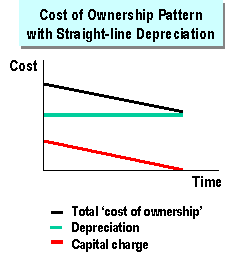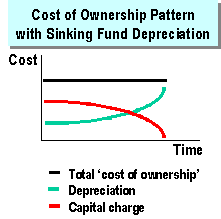Useful Life and Depreciation
The cost of purchasing equipment or facilities is capitalized under a PP&E account on the balance sheet and the account balance is depreciated over time. The amount and pattern of depreciation depends on several factors including the useful service life of the asset, its residual value at the end of that life, and the choice of depreciation method.
An asset's useful service life is based on a judgement of its physical and economic limitations. GAAP requires that the shortest useful life justified by these factors is the one that should be chosen for purposes of depreciation. Similarly, management is expected to assume the lowest residual value for a given asset in establishing its depreciation base.
By far, the straight-line method of depreciation is the most commonly used. Other depreciation methods include declining balance, sum-of-the-year' digits, and output- or unit-based. GAAP allows a choice of methods, but stresses a cost allocation closest to the pattern of service consumption associated with the asset.
For tax purposes--as distinct from financial accounting purposes--depreciation lives and methods are limited by statute, and may differ significantly from financial reporting, .e.g., straight-line for GAAP vs. accelerated for tax.
Economics of Depreciation
Few assets last forever. Land does (at least away from unprotected shorelines). Intellectual property can have economic benefit of indefinite duration. All other assets waste with use or with time.
Economically, the life of an asset can be expressed as the term over which it can generate income for the purpose for which it was acquired. Thus, a bus that is good for hauling children in the suburbs may last for six years in continuous service, with some residual value. After that, it may be useful for another ten years hauling tourists in rugged terrain. In any case, "economic life" is a valuation concept closely associated with the assets cash generating capabilities.
By contrast, "accounting life" is cost allocation concept. Any differences between an asset balance after accumulated depreciation and its market value would eventually show up as a write-off, if the asset is taken out of service, or as a gain or loss on disposition if it is sold.
Write-offs and losses on sale are evidence of under-depreciation. Gains on sale are evidence of over-depreciation. In the meantime, assets in use may generate profits that are charged an amount that bears little resemblance to the economic loss associated with the assets use, generating unrealized gains and losses
Behavioral Impact
Adopting the right kind of depreciation is basically an attempted to best match economic consumption of assets with the revenues those assets generate. An asset that is over-depreciated will look like it is performing poorer than it really is and will likely to draw less re-investment than it deserves, or encourage management to unload it to realize a gain on the sale. Conversely, an asset that is under-depreciated will look better than it really is and invite over-investment for a time, until it is discovered that it can only be unloaded at a loss or must suffer a write-off at the time is no longer useful.
When an asset's market value diverges too far from its book value, it creates large unrealized gains or losses. This may encourage managers to overlook value creating alternatives to their current use. This problem can be largely overcome if managers understand how to incorporate incremental costs and benefits in an analysis of alternative uses for any asset. The right answer will create EP improvement. However, managers cannot evaluate every asset all the time. They must prioritize their evaluation based on what is reported, and they may be lead away from promising alternatives if those alternatives are disguised in the financial statements due to poorly matched depreciation.
Alternative Treatments
Altering depreciation lives and methods

To better match the economic wasting of assets with use or time (and, presumably, their ability to generate revenue), it may be desirable to alter the lives or methods used to depreciate key assets.
This could involve lengthening or shortening expected useful lives or accelerating or decelerating depreciation.
Sinking fund
depreciation
One particular form or depreciation is called the "sinking fund" method. This method has the virtue of creating a level cost of ownership over the life of the asset.
Most depreciation methods create the illusion of growing EVA due to a declining "total cost of ownership," because the declining capital charge is not offset by a growing rate of depreciation. The sinking fund method prevents this by offsetting the decline in the capital charge component of the cost of ownership by increases in the depreciation rate--in other words, a depreciation schedule that mimics a "sinking fund."
Replacing depreciation with period unrealized gains and losses
In cases where the market value of the asset changes significantly from one period to the next, both up and down, depreciation becomes a truly arbitrary convention. In such circumstances, depreciation can be replaced by recognition of unrealized gains or losses
This treatment would be subjective and cause controversy. But it would, theoretically, result in a more perfect match between the value generating capability of the asset and its returns.